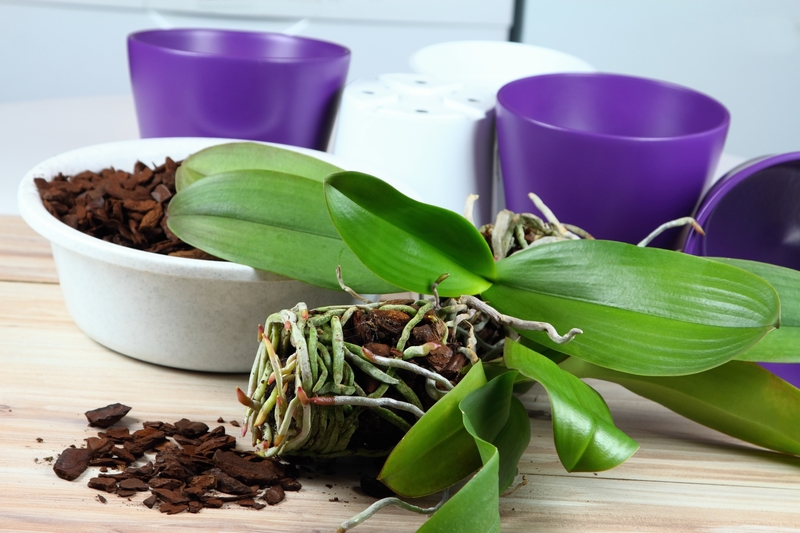Crafting a Serene Garden Amidst Whirling Winds
Posted on 02/07/2025
Crafting a Serene Garden Amidst Whirling Winds
Are you dreaming of a peaceful retreat just beyond your doorstep, but battling the persistent challenge of a windy environment? Creating a tranquil garden in a windy location may seem daunting, but with the right strategies, plant choices, and design principles, it's not only possible but rewarding. This detailed guide explores every facet of crafting a serene garden amidst whirling winds--from wind-resistant planting schemes to protected outdoor sanctuaries--so you can cultivate your own oasis of calm.
Understanding the Challenges: Gardening in Windy Climates
Before you break ground on your project, it's essential to understand how wind affects your garden. Wind can dry out the soil, damage delicate plants, and lower ambient temperatures, making your greenscape less lush and comfortable. Fortunately, recognizing these issues sets the stage for strategic solutions in your serene garden design for windy areas.
- Increased evaporation: Wind quickly dries both soil and foliage, leading to higher water consumption.
- Physical damage: Strong gusts may snap stems, bend trees, or shred foliage, especially on tender, leafy plants.
- Reduced pollinator activity: Pollinators avoid excessively windy spaces, which can hinder fruit and seed production.
- Soil erosion: Loose topsoil may be blown away, diminishing soil fertility over time.
Therefore, a thoughtful approach is needed to design a garden that not only survives but thrives amidst swirling winds.

Planning Your Wind-Resistant and Peaceful Garden
Effective planning is the cornerstone of gardening in windy conditions. Begin by studying your property and identifying the prevailing wind patterns. Observe which areas bear the brunt of the gusts and which spots seem naturally sheltered.
Assessing Wind Flow
Accurately mapping wind flow across your yard is paramount. Use temporary markers or simply observe how lightweight materials move in the wind to trace the strongest gusts. Take note of:
- Wind direction throughout different seasons
- Areas of greatest exposure
- Naturally sheltered zones (beside walls, fences, or dense shrubs)
Strategizing Your Windbreaks
Windbreaks are the backbone of any thriving garden amidst gusty weather. They function as shields, breaking the force of the wind and protecting delicate areas inside your serene enclave.
Designing Effective Windbreaks: Form Meets Function
A windbreak can range from a living barrier of shrubs and trees to custom-built fences or screens. The best windbreak for your peaceful, wind-resistant garden is usually a mixture of both natural and architectural elements.
Types of Windbreaks
- Hedges and Trees: Living windbreaks not only block wind but add beauty and biodiversity. Choose densely twigged shrubs like hawthorn, boxwood, and juniper, or sturdy trees like pine or holm oak. Arrange them in staggered rows to disrupt wind flow instead of creating turbulent eddies.
- Structural Fences: Install slatted fences, woven willow panels, or trellised screens. Solid walls can cause wind to tumble over the top and create unwanted turbulence, so opt for permeable structures that break but don't block wind entirely.
- Green Screens: Add climbing plants such as ivy, honeysuckle, or clematis to vertical structures for a lush, multi-layered wind defense.
Pro tip: The most effective windbreaks filter wind rather than stopping it completely, reducing speeds by up to 50% within an area 5-10 times the height of the barrier.
Choosing the Right Plants for Serene, Wind-Prone Gardens
Plant selection is crucial when it comes to creating a tranquil wind-resistant garden. Not all plants are suited for blustery conditions, but many have adapted to thrive under pressure. Look for:
- Sturdy, flexible stems that sway rather than snap
- Small or leathery leaves that minimize water loss and resist tearing
- Deep root systems for wind anchorage
- Native species naturally acclimated to local weather
Top Plant Choices for Windy Gardens
- Grasses and Grass-like Plants: Ornamental grasses (like Miscanthus, Cortaderia, and Panicum) bend gracefully with the wind, adding sound and movement to your serene landscape.
- Wind-Resistant Shrubs: Try sea buckthorn, oleaster, rugosa rose, and escallonia for beautiful, resilient garden structure.
- Flowering Perennials: Hardy options like lavender, sedum, coreopsis, and echinacea offer color and require minimal maintenance.
- Tough Trees: Wind-firm species such as crab apple, rowan, pine, and bay laurel make excellent anchor points.
Grouping plants is also beneficial, as plants shield each other, reducing stress from high winds.
Garden Layout Tips for Calm Amidst Wind
A well-considered layout not only makes your garden aesthetically pleasing but also ensures its serenity. Here's how to plan a relaxing sanctuary even in exposed areas:
- Arrange zones: Position seating, patios, or sensitive plants in the lee of substantial windbreaks.
- Layer heights: Gradually transition from tall windbreaks to lower shrubs and groundcovers, diffusing wind speeds across the garden.
- Curving paths and borders: Winding designs create protected microclimates and add intimacy to your garden rooms.
- Use dense planting: The more foliage, the more turbulence is dissipated, so avoid wide open spaces which invite wind corridors.
Hardscaping and Wind Management Solutions
Incorporate non-plant elements for additional protection and comfort. Whether your goal is a private reading nook, a peaceful meditation space, or a family gathering area, these garden structures can make all the difference:
- Sheltered seating: Install arbors, pergolas, or gazebos with open but shielded sides for all-weather enjoyment.
- Retaining walls and raised beds: These can redirect wind and lift sensitive plants out of the direct line of force.
- Patio wind blocks: Glass screens or louvered panels allow views but reduce blast effects.
- Water features: Trickling fountains or pools increase humidity and mask wind noise, deepening the atmosphere of calm.
By combining greenery and hardscape, you can curate a space that feels calm, inviting, and protected no matter how the wind howls.
Soil and Water Considerations in Windy Gardens
Wind exposure means soil dries rapidly, so water retention and regular irrigation become critical. Here are some tried-and-tested tips for maintaining healthy soil in breezy environments:
- Mulch generously: Organic mulch stabilizes soil temperature, reduces moisture loss, and guards against erosion.
- Improve soil structure: Amend sandy or loose soils with compost for better water retention and root anchorage.
- Drip irrigation: Minimize water loss from overhead sprinklers, which can be blown away before reaching roots.
- Soil wind shields: Plant groundcovers like thyme or creeping juniper to lock in soil and further stifle erosion.
Remember: Keeping your garden hydrated and your soil protected is just as vital as external wind defenses.
Creating Tranquil Zones: Furniture, Decor, and Ambience
Now for the fun part--designing the experience of serenity within your wind-resistant haven. Prioritize comfort and sensory pleasure:
- Comfortable seating: Choose sturdy, weather-resistant furniture that won't topple in a gust. Low-profile and weighted pieces are ideal.
- Wind chimes and sound elements: Soft tones or bamboo chimes can transform whistling winds into calming background music.
- Shade sails and canopies: Install fabric shades that also act as secondary wind filters, especially in hot climates.
- Lighting: Soft solar lanterns or string lights create an evening retreat immersive with gentle illumination.
- Scented plants: Incorporate lavender, mint, or jasmine to infuse your garden with calming natural fragrances.
A garden designed with thoughtful ambience can truly become your personal sanctuary, even when the outside world feels turbulent.
Maintenance Tips for Long-Lasting Garden Serenity
Keeping a serene garden amidst whirling winds does require vigilance, but with a few regular habits, you'll maximize your garden's health and comfort:
- Check and repair windbreaks regularly for gaps or weaknesses, especially after storms.
- Prune plants strategically to maintain shape and lower wind resistance.
- Refresh mulch seasonally to control erosion and water loss.
- Stake or support young trees and top-heavy plants until mature enough to withstand gusts.
- Rotate plantings or replace as needed with more suitable wind-resistant varieties if some don't thrive.
With care and attention, your garden will evolve into a stronger, more harmonious refuge year after year.

Frequently Asked Questions
What are the best fast-growing windbreak plants?
Some outstanding quick growers include willow, poplar, and privet. These establish quickly and can offer immediate barricade benefits, though long-term, integrate slower-growing species for durability.
How can I reduce wind noise in my garden?
Use layers of plants and barriers to absorb and muffle wind sounds. Adding flowing water features or gentle wind chimes can transform noise into soothing background ambiance.
Is it possible to grow vegetables in a windy garden?
Absolutely! Just select compact or staked varieties, use protective structures like cloches or low tunnels, and position edible beds behind windbreaks for the best results.
What should I avoid in a windy garden?
Avoid plants with delicate, broad leaves or top-heavy annuals prone to snapping. Steer clear of tall, thin fences or solid walls, as these can make wind turbulence worse.
Conclusion: Your Path to a Wind-Proof Garden Retreat
Crafting a serene garden amidst whirling winds is an exercise in creativity, resilience, and balance. By understanding the unique challenges of wind, employing effective windbreaks, choosing the right plants and layout, and enhancing your outdoor experience with thoughtful design, you can transform a windswept space into a peaceful shelter. Let every gust of wind remind you of the harmony between nature's wildness and the enduring tranquility you've built right at home.
Embrace the breeze and start your journey toward a calm, wind-smart garden oasis today!

